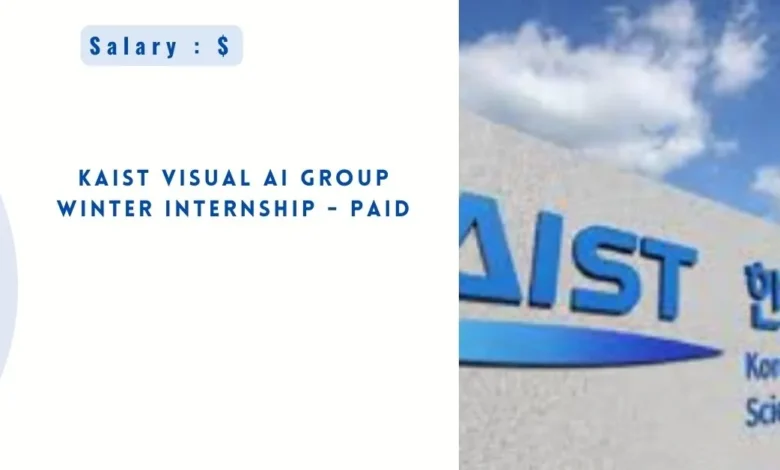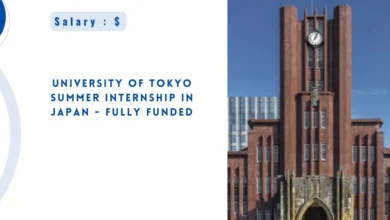KAIST Visual AI Group Winter Internship – PAID

The KAIST Visual AI Group Winter Internship 2024 is now accepting applications. The KAIST University in South Korea is offering a paid research internship. The internship lasts for about eight weeks or 57 days. The Winter Internship at KAIST Visual AI Group will run from December 26, 2024, to February 21, 2025. International students who are not enrolled in any Korean colleges may also apply for the internship, as could non-KAIST students. During their internship, interns must be physically present as they will be working in the lab. The internship’s goal is to choose bright undergraduates to assist in creating state-of-the-art machine-learning solutions for visual data. Details are provided below.
Details About KAIST Visual AI Group Winter Internship 2024
- Host Country: South Korea
- University: Korea Advanced Institute of Science and Technology
- Duration: December 26, 2024, to February 21, 2025
- Location: Daejeon, South Korea
Research Areas
The research areas mentioned focus on advanced and emerging topics in the field of artificial intelligence (AI) and machine learning. Here is a breakdown of each:
- Diffusion Models / Flow-Based Generative Models:
- Generative models of this type are employed to produce high-quality samples from intricate data distributions. They are especially well-known for their capacity to produce sounds, pictures, and other types of data through normalizing fluxes or diffusion processes.
- Generative Models for Diverse Data Types:
- This field investigates generative models (such as GANs, VAEs, etc.) that are capable of processing text, audio, images, and even structured data. The objective is to develop models that can generate a variety of realistic outcomes.
- 3D Generation, Editing, and Deformation:
- The creation and modification of 3D objects and scenes with deep learning methods is the main emphasis of this study. Applications include creating 3D models, modifying them (by altering their structures, textures, or forms), and deforming objects to create lifelike animations or simulations fall under this category.
- Foundation Models (LLMs / VLMs):
- Large Language Models (LLMs) and Vision-Language Models (VLMs) are examples of foundation models that are substantially pre-trained and made to do tasks in a variety of areas. While VLMs, like CLIP or DALL-E, integrate text and image data for multi-modal learning, LLMs, like GPT and BERT, concentrate on text-based applications.
- Video Generative Models:
- Generative models that can create movies or other time-series data are used in this sector. These models can modify current movies or create new, realistic video material from start by learning the temporal patterns in videos.
- Neural Rendering:
- The process of using neural networks to create lifelike images or animations from 3D models is known as neural rendering. Applications like high-fidelity graphics creation, augmented reality, and virtual reality are included in this.
- Neural Operators / AI for Scientific Applications:
- In fields including materials science, physics, and biology, this research area uses deep learning to solve scientific problems like partial differential equations (PDEs), simulate physical occurrences, or make predictions. Faster simulations and analyses are made possible by neural operators, which are models that can approximate solutions to challenging mathematical equations.
Benefits
- Both computing resources and compensation will be given to interns.
- Administrative limitations prevent students attending universities outside of Korea from receiving payment.
Intern’s Responsibilities
Develop Deep Learning Techniques:
- Deep learning models, especially those pertaining to more complex fields like generative models and 3D data processing, will be developed by interns.
Physical Presence Requirement:
- From December 26, 2024, to February 21, 2025, interns must be physically present at KAIST, which is located at N1 Bldg, Rm 622, 291 Daehak-ro, Yuseong-gu, Daejeon, Korea 34141.
Preferred Coursework Experience:
- Candidates who have completed or audited courses like “Diffusion Models and Their Applications” and/or “Machine Learning for 3D Data” are encouraged for this role, while it is not required.
Extension of Internship:
- With the possibility to work remotely during that time, interns may be able to prolong their internship into the next semester.
Read Also: ETH Summer Internship in Switzerland – Fully Funded
Eligibility Criteri
Non-KAIST Students:
- The internship is open to students who are not enrolled at KAIST at the moment.
International Students:
- Applications for internships at KAIST are also open to foreign students who are not currently enrolled in any Korean educational institution.
Required Documents
- Transcript
- CV/Resume (including research, internship, and project experience, as well as programming skills).
How to Apply
Conclusion:
Students interested in AI and machine learning have a rare opportunity to participate to cutting-edge research at one of South Korea’s best universities with the KAIST Visual AI Group Winter Internship 2024. This internship offers significant skills and networking possibilities, including the opportunity to work with top experts in the area and gain practical experience in advanced AI themes. For a chance to participate in this fascinating program, apply now!
Frequently Asked Questions
-
What is the KAIST Visual AI Group Winter Internship
The Korea Advanced Institute of Science and Technology (KAIST) in South Korea is hosting the paid research internship known as the KAIST Visual AI Group Winter Internship 2024. It focuses on state-of-the-art machine learning methods for visual data, such as 3D generation and generative models. The internship is available to both international and non-KAIST students and runs from December 26, 2024, until February 21, 2025.
-
What are the benefits of the KAIST Visual AI Group Winter Internship?
In addition to remuneration, interns will have access to computer resources. However, because of administrative restrictions, students who do not attend Korean universities will not receive compensation.




